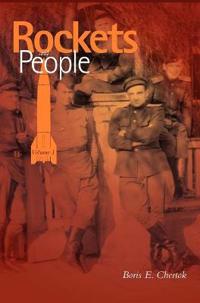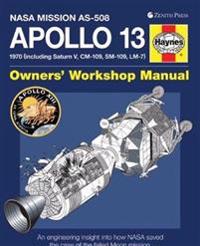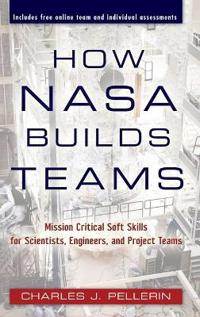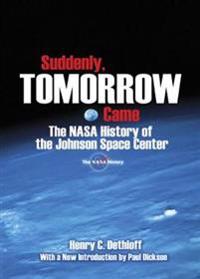NASA Systems Engineering Handbook (NASA/SP-2007-6105 Rev1) (Häftad)
avNASA Headquarters
ISBN: 9781780391380 - UTGIVEN: 2007-12Rockets and People, Volume I (NASA History Series. NASA Sp-2005-4110) (Inbunden)
avBoris Chertok, Nasa History Office, Asif A. Siddiqi
ISBN: 9781780396880 - UTGIVEN: 2005-02From Engineering Science to Big Science: The NACA and NASA Collier Trophy Research Project Winners (Häftad)
avNASA, Pamela E. Mack
ISBN: 9781410225313 - UTGIVEN: 200603Critical Issues in the History of Spaceflight (NASA Publication Sp-2006-4702) (Inbunden)
avSteven J. Dick, Roger D. Launius, Nasa History Division
ISBN: 9781780396835 - UTGIVEN: 2006-01Rockets and People, Volume II: Creating a Rocket Industry (NASA History Series Sp-2006-4110) (Inbunden)
avBoris Chertok, Nasa History Division, Asif Siddiqi
ISBN: 9781780396897 - UTGIVEN: 2006-06Much has been written in the West on the history of the Soviet space program but few Westerners have read direct first-hand accounts of the men and women who were behind the many Russian accomplishments in exploring space. The memoir of Academician Boris Chertok, translated from the original Russian[...]
NASA Project Gemini Familiarization Manual Manned Satellite Spacecraft (Häftad)
avNASA
ISBN: 9781935700692 - UTGIVEN: 2011-05NASA Space Shuttle Transportation System Manual (Häftad)
avNASA, Rockwell International
ISBN: 9781935700845 - UTGIVEN: 201108NASA Apollo Spacecraft Command and Service Module News Reference (Häftad)
avNASA
ISBN: 9781937684990 - UTGIVEN: 201109Apollo 13 Owners' Workshop Manual: NASA Mission AS-508: 1970 (Including Saturn V, CM-109, SM-109, LM-7): An Engineering Insight Into How NASA Saved th (Inbunden)
avDavid Baker
ISBN: 9780760346198 - UTGIVEN: 2013-10The world-famous Apollo 13 mission and dramatic explosion on the service module, captured in technical detail like you've never seen before. On April 13, 1970, NASA's Apollo 13 suffered a near-catastrophic explosion in space. The planned lunar landing that day was promptly called off, and a new chal[...]
NASA's First 50 Years Historical Perspectives: NASA 50th Anniversary Proceedings (Häftad)
avStephen J. Dick
ISBN: 9781470024758 - UTGIVEN: 2010-08NASA Systems Engineering Handbook: NASA/Sp-2007-6105 Rev1 (häftad)
ISBN: 9781537276687 - UTGIVEN: 2016-08NASA at 50: Interviews with NASA's Senior Leadership (Häftad)
avSteven J. Dick, Rebecca Wright
ISBN: 9781782663041 - UTGIVEN: 2013-01NASA Systems Engineering Handbook - NASA Sp-2016-6105 Rev2: Design Test Integrate Fly (häftad)
ISBN: 9781977821966 - UTGIVEN: 2017-10The NASA Systems Engineering Handbook Rev 2
An updated edition of NASA's original engineering manual SP-2007-6105 with extensive use of boxes and figures to define, illustrate, and extend concepts in the chapters. This handbook provides top-level guidance for good systems engineering practices.<[...]NASA Systems Engineering Handbook (NASA Sp-2016-6105 Rev2) (häftad)
ISBN: 9781979381475 - UTGIVEN: 2017-11This handbook, "NASA Systems Engineering Handbook," is intended to provide general guidance and information on systems engineering that will be useful to the NASA community. It provides a generic description of Systems Engineering (SE) as it should be applied throughout NASA. A goal of the handbook [...]
Innovation The Nasa Way (Inbunden)
avRod Pyle
ISBN: 9780071829137 - UTGIVEN: 2014-04Launch your business to new heights with out-of-this world innovation. For over half a century, NASA has delivered a continuous stream of innovative accomplishments that have inspired the world. Neil Armstrong walking on the moon, the space shuttle pioneering reusable space planes, Mars rovers explo[...]
How NASA Builds Teams: Mission Critical Soft Skills for Scientists, Engineers, and Project Teams (Inbunden)
avCharles J. Pellerin
ISBN: 9780470456484 - UTGIVEN: 200907Every successful organization needs high-performance teams to compete and succeed. Yet, technical people are often resistant to traditional "touchy-feely" teambuilding. To improve communication, performance, and morale among NASA's technical teams, former NASA Astrophysicist Dr.[...]
Suddenly, Tomorrow Came: The NASA History of the Johnson Space Center (Häftad)
ISBN: 9780486477565 - UTGIVEN: 2012-10As the astronauts' home base and the site of Mission Control, the Johnson Space Center has witnessed some of America's most triumphant moments. This illustrated NASA history traces the center's development, from its origins through the Mercury, Gemini, and Apollo programs and to shuttle missions and[...]
Moonshots: 50 Years of NASA Space Exploration Seen Through Hasselblad Cameras
ISBN: 9780760352625 - UTGIVEN: 2017-10In December 1968, the crew of Apollo 8 captured images depicting Earth hanging like a lonely fruit in the vast darkness of space. The social and spiritual shock of that photograph--and those which followed--never fully diminished, even as Apollo missions followed at an incredible pace, including the[...]
NASA Mission As-506 Apollo 11 Owner's Workshop Manual: 50th Anniversary Special Edition - An Insight Into the Hardware from the First Manned Mission t
ISBN: 9780760366578 - UTGIVEN: 2019-05To celebrate the 50th anniversary of the 20th century's greatest flight achievement, this book chronicles how 400,000 men and women across the US worked to transport human beings across a quarter million miles of hostile space to an unexplored world, and how they ensured that the seven million engin[...]
NASA/ART (Inbunden)
ISBN: 9780810972872 - UTGIVEN: 2008-10NASA is special among agencies of the United States government in that its mission - to explore space - is to be constantly probing into the unknown. Astronauts and artists have this in common. Soon after the establishment of NASA in 1959, the NASA Art Program was created, in recognition that artist[...]
Haynes NASA Gemini 1965-1966 (All Missions, All Models) Owners' Workshop Manual (Inbunden)
avDavid Woods, David M. Harland, David Woods
ISBN: 9780857334213 - UTGIVEN: 2015-01NASA's Gemini space flight programme followed on from the pioneering Mercury missions which put the first US astronauts into space. The Gemini spacecraft was an agile flying machine for fighter pilots, which gave the US the tool it needed to fly into space, and in doing so prepared NASA to travel to[...]
Haynes Nasa Voyager 1 & 2 Owners' Workshop Manual (Inbunden)
avChristopher Riley, Richard Corfield, Philip Dolling
ISBN: 9780857337757 - UTGIVEN: 2015-08Voyager 1 has recently crossed the boundary of our solar system and passed into interstellar space, and Voyager 2 is likely to follow suit, on a different path, between 2016 and 2017. The two Voyager probes will continue to transmit details of discoveries beyond our solar system until at least 2020.[...]
Haynes Nasa Hubble Space Telescope 1990 Onwards - Including All Upgrades (Inbunden)
avDavid Baker
ISBN: 9780857337979 - UTGIVEN: 2015-07The Hubble Space Telescope is an international venture primarily between the USA and Europe. More than any other space project, Hubble has encouraged an expanding interest in popular astronomy. With stunning views of the cosmos, it has inspired a new generation of enthusiasts to study the night sky [...]



























